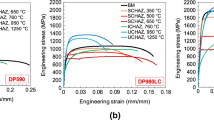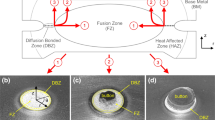Abstract
The use of coated press-hardened steels (PHS) in body-in-white (BiW) components provides significant potential for weight reduction, but leads to decrease in joinability, thus creating challenge to produce welds meeting commercial quality requirements. Welding with longer welding times can improve joinability, but causes softening at the fusion boundary of spot welds due to local decarburization, referred to as a “halo” at the fusion boundary. In the present work, RSW with and without a softened region at the fusion boundary were fabricated. The geometry and hardness of the halo were obtained from high-resolution hardness mappings and transferred to an FE model, which was used to predict mechanical performance and fracture mode of spot welds in lap-shear and cross-tension tests. The developed FE model was verified experimentally and allowed for an accurate prediction of failure modes while demonstrating that the presence of the halo ring affects the location of failure as well as the load–displacement response of spot welds.










Similar content being viewed by others
References
Briskham P, Blundell N, Han L et al (2006) Comparison of Self-Pierce Riveting, Resistance Spot Welding and Spot Friction Joining for Aluminium Automotive Sheet. In: SAE Technical Paper Series. SAE International400 Commonwealth Drive, Warrendale, PA, United States
Altan T, Tekkaya AE (eds) (2012) Sheet metal forming. Processes and applications. ASM International, Materials Park, OH
Sherepenko O, Schreiber V, Schischin I et al (2020) Influence of surface layers on resistance spot joinability of partially hardened steel 22MnB5 with aluminum-silicon and zinc coatings. Weld World 64:755–771. https://doi.org/10.1007/s40194-020-00864-9
Laurenz R, Ohse P (2012) Einfluss der Ofenverweilzeit von metallisch überzogenem Warmumformstahl auf die Eignung zum Widerstandspunkt-, Buckel- und Lichtbogenbolzenschweißen. Schweißen und Schneiden 64:654–661
Rosner M (2015) Kleben von verzinktem presshärtenden Stahl. In: DVS Media GmbH (ed) DVS Congress 2015: Grosse Schweisstechnische Tagung : DVS-Studentenkongress : Fügen von faserverstärkten Kunststoffen, anwendungsnahe Schweisssimulation, Schulung und Prüfung im DVS : IBESS - Forschungscluster "Bruchmechanik" : Vorträge der gleichnamigen Tagung im Rahmen von DVS Congress und DVS Expo in Nürnberg vom 15. bis 17. September 2015. DVS Media, Düsseldorf, pp 414–418
Eller TK (2016) Modeling of tailor hardened boron steel for crash simulation: Twente Univ., Diss. University of Twente, Enschede
Schuster L, Sommer S Characterization and modelling of soft zones around spot welds in high strength steels. In: Proceedings of the 5thinternational conference on steels in cars and trucks Steels in Cars and Trucks 2017
Sherepenko O, Kazemi O, Rosemann P et al (2020) Transient softening at the fusion boundary of resistance spot welds: a phase field simulation and experimental investigations for Al–Si-coated 22MnB5. Metals 10:10. https://doi.org/10.3390/met10010010
Sherepenko O, Jüttner S (2019) Transient softening at the fusion boundary in resistance spot welded ultra-high strengths steel 22MnB5 and its impact on fracture processes. Weld World 63:151–159. https://doi.org/10.1007/s40194-018-0633-3
Pouranvari M, Sobhani S, Goodarzi F (2018) Resistance spot welding of MS1200 martensitic advanced high strength steel: Microstructure-properties relationship. J Manuf Process 31:867–874. https://doi.org/10.1016/j.jmapro.2018.01.009
Tamizi M, Pouranvari M, Movahedi M (2016) Welding metallurgy of martensitic advanced high strength steels during resistance spot welding. Sci Tech Weld Join 1–9.https://doi.org/10.1080/13621718.2016.1240979
Rezayat H, Ghassemi-Armaki H, Bhat SP et al (2019) Constitutive properties and plastic instabilities in the heat-affected zones of advanced high-strength steel spot welds. J Mater Sci 54:5825–5843. https://doi.org/10.1007/s10853-018-03276-9
Lu Y, Peer A, Abke T et al (2018) Subcritical heat affected zone softening in hot-stamped boron steel during resistance spot welding. Mater Des 155:170–184. https://doi.org/10.1016/j.matdes.2018.05.067
Huin T, Dancette S, FabrÈgue D et al (2016) Investigation of the failure of advanced high strength steels heterogeneous spot welds. Metals 6:111. https://doi.org/10.3390/met6050111
Mohamadizadeh A, Biro E, Worswick M (2020) Shear band formation at the fusion boundary and failure behaviour of resistance spot welds in ultra-high-strength hot-stamped steel. Sci Tech Weld Join 2: 1–8. https://doi.org/10.1080/13621718.2020.1773057
Mohamadizadeh A, Biro E, Worswick M et al. (2019) Spot weld strength modeling and processing maps for hot-stamping steels. WJ 98: 241–249. doi https://doi.org/10.29391/2019/98.021
Qiao Z, Li H, Li L et al (2019) Microstructure and properties of spot welded joints of hot-stamped ultra-high strength steel used for automotive body structures. Metals 9: 285
Zhao Y, Zhang Y, Lai X (2018) Analysis of Fracture Modes of Resistance Spot Welded Hot-Stamped Boron Steel. Metals 8:764. https://doi.org/10.3390/met8100764
DIN EN ISO 5821:2010–04, Resistance welding - Spot welding electrode caps (ISO 5821:2009); German version EN ISO 5821:2009
DIN EN ISO 14272 : 2016–11 Destructive testing of welds - Specimen dimensions and procedure for cross tension testing of resistance spot and embossed projection welds
DIN EN ISO 14273:2016–11, Resistance welding - Destructive testing of welds - Specimen dimensions and procedure for tensile shear testing resistance spot and embossed projection welds (ISO 14273:2016); German version EN ISO 14273:2016
DIN EN ISO 6507–1:2018–07, Metallic materials - Vickers hardness test - Part 1: Test method (ISO 6507–1:2018); German version EN ISO 6507–1:2018
Deutscher Verband für Schweißen und verwandte Verfahren e.V. (2015) DVS 2960: Unregelmäßigkeiten bei Widerstandspunktschweißverbindungen an Stahlwerkstoffen
Veit J (2014) Untersuchungen zum artgleichen Widerstandspunktschweißen von hochmanganhaltigen TWIP-Stählen für den Automobilbau. TU Clausthal, Diss., 2013. Papierflieger-Verl., Clausthal-Zellerfeld
Bardelcik A, Worswick MJ, Winkler S et al (2012) A strain rate sensitive constitutive model for quenched boron steel with tailored properties. Int J Impact Eng 50:49–62. https://doi.org/10.1016/j.ijimpeng.2012.06.007
Bai Y, Wierzbicki T (2008) A new model of metal plasticity and fracture with pressure and Lode dependence. Int J Plast 24:1071–1096. https://doi.org/10.1016/j.ijplas.2007.09.004
Kortenaar L ten (2016) Failure Characterization of Hot Formed Boron Steels with Tailored Mechanical Properties. http://hdl.handle.net/10012/10351
American Welding Society (2013) AWS D8.1M, 2nd Edition, Specification for Automotive Weld Quality-Resistance Spot Welding of Steel
Acknowledgements
The authors thank Honda R&D Americas Inc., Promatek Research Centre, ArcelorMittal, the Natural Sciences and Engineering Research Council (NSERC) of Canada and the Ontario Advanced Manufacturing Consortium for their funding of this work. Equal thanks go to AiF for funding the IGF-Project IGF-Nr.:18.939B (DVS-Nr.: 04.060) of the Research Association on Welding and Allied Processes of the DVS, which was part of the program to support cooperative industrial research (Industrielle Gemeinschaftsforschung (IGF)) by the Federal Ministry for Economic Affairs and Energy, following a decision of the German Bundestag. We also thank all companies, colleagues, and students who contributed their support, knowledge, and effort to the project.
Author information
Authors and Affiliations
Corresponding author
Additional information
Handling Editor: Sophie Primig.
Publisher's Note
Springer Nature remains neutral with regard to jurisdictional claims in published maps and institutional affiliations.
Rights and permissions
About this article
Cite this article
Sherepenko, O., Mohamadizadeh, A., Zvorykina, A. et al. Determination of resistance spot weld failure path in ultra-high-strength press-hardened steel by control of fusion boundary transient softening. J Mater Sci 56, 14287–14297 (2021). https://doi.org/10.1007/s10853-021-06165-w
Received:
Accepted:
Published:
Issue Date:
DOI: https://doi.org/10.1007/s10853-021-06165-w




